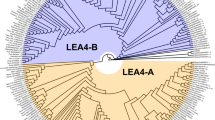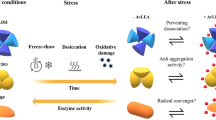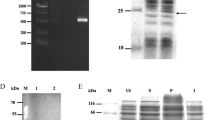Abstract
Main conclusion
Expression of eight LEA genes enhanced desiccation tolerance in yeast, including two LEA_2 genes encoding atypical, stably folded proteins. The recombinant proteins showed enzyme, but not membrane protection during drying.
To screen for possible functions of late embryogenesis abundant (LEA) proteins in cellular stress tolerance, 15 candidate genes from six Arabidopsis thaliana LEA protein families were expressed in Saccharomyces cerevisiae as a genetically amenable eukaryotic model organism. Desiccation stress experiments showed that eight of the 15 LEA proteins significantly enhanced yeast survival. While none of the proteins belonging to the LEA_1, LEA_5 or AtM families provided protection to yeast cells, two of three LEA_2 proteins, all three LEA_4 proteins and three of four dehydrins were effective. However, no significantly enhanced tolerance toward freezing, salt, osmotic or oxidative stress was observed. While most LEA proteins are highly hydrophilic and intrinsically disordered, LEA_2 proteins are “atypical”, since they are more hydrophobic and possess a stable folded structure in solution. Because nothing was known about the functional properties of LEA_2 proteins, we expressed the three Arabidopsis proteins LEA1, LEA26 and LEA27 in Escherichia coli. The bacteria expressed all three proteins in inclusion bodies from which they could be purified and refolded. Correct folding was ascertained by Fourier transform Infrared (FTIR) spectroscopy. None of the proteins was able to stabilize liposomes during freezing or drying, but they were all able to protect the enzyme lactate dehydrogenase (LDH) from inactivation during freezing. Significantly, only LEA1 and LEA27, which also protected yeast cells during drying, were able to stabilize LDH during desiccation and subsequent rehydration.








Similar content being viewed by others
Abbreviations
- BSA:
-
Bovine serum albumin
- CFU:
-
Colony-forming units
- CD:
-
Circular dichroism
- CF:
-
Carboxyfluorescein
- EPC:
-
Egg phosphatidylcholine
- FTIR:
-
Fourier transform infrared
- GFP:
-
Green fluorescent protein
- GOI:
-
Gene of interest
- GRAVY:
-
Grand average of hydropathy
- IDP:
-
Intrinsically disordered protein
- LDH:
-
Lactate dehydrogenase
- LEA:
-
Late embryogenesis abundant
- POPC:
-
1-Palmitoyl-2-oleoyl-phosphatidylcholine
- RH:
-
Relative humidity
- TEN:
-
Tes, EDTA, NaCl buffer
References
Arrondo JLR, Goni FM (1999) Structure and dynamics of membrane proteins as studied by infrared spectroscopy. Prog Biophys Mol Biol 72:367–405
Arrondo JLR, Muga A, Castresana J, Goni FM (1993) Quantitative studies of the structure of proteins in solution by Fourier-transform infrared spectroscopy. Progr Biophys Mol Biol 59:26–56
Artus NN, Uemura M, Steponkus PL, Gilmour SJ, Lin C, Thomashow MF (1996) Constitutive expression of the cold-regulated Arabidopsis thaliana COR15a gene affects both chloroplast and protoplast freezing tolerance. Proc Natl Acad Sci USA 93:13404–13409
Barth A (2007) Infrared spectroscopy of proteins. Biochim Biophys Acta 1767:1073–1101
Battaglia M, Olvera-Carrillo Y, Garciarrubio A, Campos F, Covarrubias AA (2008) The enigmatic LEA proteins and other hydrophilins. Plant Physiol 148:6–24
Bies-Etheve N, Gaubier-Comella P, Debures A, Lasserre E, Jobet E, Raynal M, Cooke R, Delseny M (2008) Inventory, evolution and expression profiling diversity of the LEA (late embryogenesis abundant) protein gene family in Arabidopsis thaliana. Plant Mol Biol 67:107–124
Bokor M, Csizmok V, Kovacs D, Banki P, Friedrich P, Tompa P, Tompa K (2005) NMR relaxation studies on the hydrate layer of intrinsically unstructured proteins. Biophys J 88:2030–2037
Bray EA (1993) Molecular responses to water deficit. Plant Physiol 103:1035–1040
Byler DM, Susi H (1986) Examination of the secondary structure of proteins by deconvolved FTIR spectra. Biopolymers 25:469–487
Cacela C, Hincha DK (2006) Low amounts of sucrose are sufficient to depress the phase transition temperature of dry phosphatidylcholine, but not for lyoprotection of liposomes. Biophys J 90:2831–2842
Cheng Z, Targolli J, Huang X, Wu R (2002) Wheat LEA genes, PMA80 and PMA1959, enhance dehydration tolerance of transgenic rice (Oryza sativa L.). Mol Breed 10:71–82
Dang NX, Hincha DK (2011) Identification of two hydrophilins that contribute to the desiccation and freezing tolerance of yeast (Saccharomyces cerevisiae) cells. Cryobiology 62:188–193
Dong A, Matsuura J, Manning MC, Carpenter JF (1998) Intermolecular β-sheet results from trifluoroethanol-induced nonnative α-helical structure in β-sheet predominant proteins: infrared and circular dichroism spectroscopic study. Arch Biochem Biophys 355:275–281
Dure L III, Greenway SC, Galau GA (1981) Developmental biochemistry of cottonseed embryogenesis and germination: changing messenger ribonucleic acid populations as shown by in vitro and in vivo protein synthesis. Biochemistry 20:4162–4168
Hand SC, Menze MA, Toner M, Boswell L, Moore D (2011) LEA proteins during water stress: not just for plants anymore. Annu Rev Physiol 73:115–134
Hincha DK, Thalhammer A (2012) LEA proteins: IDPs with versatile functions in cellular dehydration tolerance. Biochem Soc Trans 40:1000–1003
Hincha DK, Oliver AE, Crowe JH (1998) The effects of chloroplast lipids on the stability of liposomes during freezing and drying. Biochim Biophys Acta 1368:150–160
Hincha DK, Zuther E, Hellwege EM, Heyer AG (2002) Specific effects of fructo- and gluco-oligosaccharides in the preservation of liposomes during drying. Glycobiology 12:103–110
Hincha DK, Espinoza C, Zuther E (2012) Transcriptomic and metabolomic approaches to the analysis of plant freezing tolerance and cold acclimation. In: Tuteja N, Gill SS, Tiburcio AF, Tuteja R (eds) Improving crop resistance to abiotic stress. Wiley-Blackwell, Berlin, pp 255–287
Hundertmark M, Hincha DK (2008) LEA (Late Embryogenesis Abundant) proteins and their encoding genes in Arabidopsis thaliana. BMC Genom 9:118
Hundertmark M, Buitink J, Leprince O, Hincha DK (2011a) The reduction of seed-specific dehydrins reduces seed longevity in Arabidopsis thaliana. Seed Sci Res 21:165–173
Hundertmark M, Dimova R, Lengefeld J, Seckler R, Hincha DK (2011b) The intrinsically disordered late embryogenesis abundant protein LEA18 modulates membrane stability through binding and folding. Biochim Biophys Acta 1808:446–453
Hundertmark M, Popova AV, Rausch S, Seckler R, Hincha DK (2012) Influence of drying on the secondary structure of intrinsically disordered and globular proteins. Biochem Biophys Res Commun 417:122–128
Imai R, Chang L, Ohta A, Bray EA, Takagi M (1996) A lea-class gene of tomato confers salt and freezing tolerance when expressed in Saccharomyces cerevisiae. Gene 170:243–248
Kim H-S, Lee JH, Kim JJ, Kim C-H, Jun S–S, Hong Y-N (2005) Molecular and functional characterization of CaLEA6, the gene for a hydrophobic LEA protein from Capsicum annuum. Gene 344:115–123
Kovacs D, Kalmar E, Torok Z, Tompa P (2008) Chaperone activity of ERD10 and ERD14, two disordered stress-related plant proteins. Plant Physiol 147:381–390
Liu Y, Zheng Y (2005) PM2, a group 3 LEA protein from soybean, and its 22-mer repeating region confer salt tolerance in Escherichia coli. Biochem Biophys Res Commun 311:325–332
MacDonald RC, MacDonald RI, Menco BPM, Takeshita K, Subbarao NK, Hu L (1991) Small-volume extrusion apparatus for preparation of large, unilamellar vesicles. Biochim Biophys Acta 1061:297–303
Maitra N, Cushman JC (1994) Isolation and characterization of a drought-induced soybean cDNA encoding a D95 family late-embryogenesis abundant protein. Plant Physiol 106:805–806
Mouillon J-M, Gustafsson P, Harryson P (2006) Structural investigation of disordered stress proteins. Comparison of full-length dehydrins with isolated peptides of their conserved segments. Plant Physiol 141:638–650
Mouillon J-M, Eriksson SK, Harryson P (2008) Mimicking the plant cell interior under water stress by macromolecular crowding: disordered dehydrin proteins are highly resistant to structural collapse. Plant Physiol 148:1925–1937
Mowla SB, Cuypers A, Driscoll SP, Kiddle G, Thomson J, Foyer CH, Theodoulou FL (2006) Yeast complementation reveals a role for an Arabidopsis thaliana late embryogenesis abundant (LEA)-like protein in oxidative stress tolerance. Plant J 48:743–756
NDong C, Danyluk J, Wilson KE, Pocock T, Huner NPA, Sarhan F (2002) Cold-regulated cereal chloroplast late embryogenesis abundant-like proteins. Molecular characterization and functional analysis. Plant Physiol 129:1368–1381
Oliver AE, Hincha DK, Crowe LM, Crowe JH (1998) Interactions of arbutin with dry and hydrated bilayers. Biochim Biophys Acta 1370:87–97
Olvera-Carrillo Y, Campos F, Reyes JL, Garciarrubio A, Covarrubias AA (2010) Functional analysis of the Group 4 late embryogenesis abundant proteins reveals their relevance in the adaptive response during water deficit in Arabidopsis. Plant Physiol 154:373–390
Park SC, Kim YH, Jeong JC, Kim CY, Lee HS, Bang JW, Kwak SS (2011) Sweetpotato late embryogenesis abundant 14 (IbLEA14) gene influences lignification and increases osmotic- and salt stress-tolerance of transgenic calli. Planta 233:621–634
Popova AV, Hincha DK (2003) Intermolecular interactions in dry and rehydrated pure and mixed bilayers of phosphatidylcholine and digalactosyldiacylglycerol: a Fourier-transform infrared spectroscopy study. Biophys J 85:1682–1690
Popova AV, Hincha DK (2007) Effects of cholesterol on dry bilayers: interactions between phosphatidylcholine unsaturation and glycolipid or free sugar. Biophys J 93:1204–1214
Popova AV, Hundertmark M, Seckler R, Hincha DK (2011) Structural transitions in the intrinsically disordered plant dehydration stress protein LEA7 upon drying are modulated by the presence of membranes. Biochim Biophys Acta 1808:1879–1887
Puhakainen T, Hess MW, Mäkelä P, Svensson J, Heino P, Palva ET (2004) Overexpression of multiple dehydrin genes enhances tolerance to freezing stress in Arabidopsis. Plant Mol Biol 54:743–753
R Development Core Team (2010) R: a language and environment for statistical computing. R Foundation for Statistical Computing, Vienna
Reyes JL, Rodrigo M-J, Colmenero-Flores JM, Gil J-V, Garay-Arroyo A, Campos F, Salamini F, Bartels D, Covarrubias AA (2005) Hydrophilins from distant organisms can protect enzymatic activities from water limitation effects in vitro. Plant Cell Environ 28:709–718
Reyes JL, Campos F, Wei H, Arora R, Yang Y, Karlsson DT, Covarrubias AA (2008) Functional dissection of hydrophilins during in vitro freeze protection. Plant Cell Environ 31:1781–1790
Rockland LB (1960) Saturated salt solutions for static control of relative humidity between 5 °C and 40 °C. Anal Chem 32:1375–1376
Sakurai T, Satou M, Akiyama K, Iida K, Seki M, Kuromori T, Itoh M, Konagaya A, Toyoda T, Shinozaki K (2005) RARGE: a large-scale database of RIKEN Arabidopsis resources ranging from transcriptome to phenome. Nucl Acids Res 33:D647–D650
Seki M, Narusaka M, Kamiya A, Ishida J, Satou M, Sakurai T, Nakajima M, Enju A, Akiyama K, Oono Y, Muramatsu M, Hayashizaki Y, Kawai J, Carninci P, Itoh M, Ishii Y, Arakawa T, Shibata K, Shinagawa A, Shinozaki K (2002) Functional annotation of a full-length Arabidopsis cDNA collection. Science 296:141–145
Singh S, Cornilescu CC, Tyler RC, Cornilescu G, Tonelli M, Lee MS, Markley JL (2005) Solution structure of a late embryogenesis abundant protein (LEA14) from Arabidopsis thaliana, a cellular stress protein. Protein Sci 14:2601–2609
Sivamani E, Bahieldin A, Wraith JM, Al-Niemi T, Dyer WE, Ho T-HD, Qu R (2000) Improved biomass productivity and water use efficiency under water deficit conditions in transgenic wheat constitutively expressing the barley HVA1 gene. Plant Sci 155:1–9
Song J, Tyler RC, Lee MS, Markley JL (2005) Solution structure of a putative late embryogenesis abundant (LEA) protein At2g46140. PDB—Protein Data Bank
Sun X, Rikkerink EHA, Jones WT, Uversky VN (2013) Multifarious roles of intrinsic disorder in proteins illustrate its broad impact on plant biology. Plant Cell 25:38–55
Surewicz WK, Mantsch HH (1988) New insight into protein structure from resolution-enhanced infrared spectra. Biochim Biophys Acta 952:115–130
Susi H, Byler M (1986) Resolution-enhanced Fourier transform infrared spectroscopy of enzymes. Meth Enzymol 130:290–311
Swire-Clark GA, Marcotte WR (1999) The wheat LEA protein Em functions as an osmoprotective molecule in Saccharomyces cerevisiae. Plant Mol Biol 39:117–128
Tolleter D, Hincha DK, Macherel D (2010) A mitochondrial late embryogenesis abundant protein stabilizes model membranes in the dry state. Biochim Biophys Acta 1798:1926–1933
Tompa P, Banki P, Bokor M, Kamasa P, Kovacs D, Lasanda G, Tompa K (2006) Protein-water and protein-buffer interactions in the aqueous solution of an intrinsically unstructured plant dehydrin: NMR intensity and DSC aspects. Biophys J 91:2243–2249
Tunnacliffe A, Hincha DK, Leprince O, Macherel D (2010) LEA proteins: versatility of form and function. In: Lubzens E, Cerda J, Clark M (eds) Sleeping beauties—dormancy and resistance in harsh environments. Springer, Berlin, pp 91–108
Xu D, Duan X, Wang B, Hong B, Ho T-HD, Wu R (1996) Expression of a late embryogenesis abundant protein gene, HVA1, from barley confers tolerance to water deficit and salt stress in transgenic rice. Plant Physiol 110:249–257
Zegzouti H, Jones B, Marty C, Lelievre J-M, Latche A, Pech J-C, Bouzayen M (1997) ER5, a tomato cDNA encoding an ethylene-responsive LEA-like protein: characterization and expression in response to drought, ABA and wounding. Plant Mol Biol 35:847–854
Zhang L, Ohta A, Takagi M, Imai R (2000) Expression of plant group 2 and group 3 lea genes in Saccharomyces cerevisiae revealed functional divergence among LEA proteins. J Biochem 127:611–616
Author information
Authors and Affiliations
Corresponding author
Rights and permissions
About this article
Cite this article
Dang, N.X., Popova, A.V., Hundertmark, M. et al. Functional characterization of selected LEA proteins from Arabidopsis thaliana in yeast and in vitro. Planta 240, 325–336 (2014). https://doi.org/10.1007/s00425-014-2089-z
Received:
Accepted:
Published:
Issue Date:
DOI: https://doi.org/10.1007/s00425-014-2089-z




